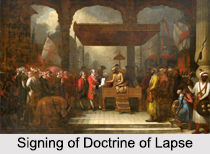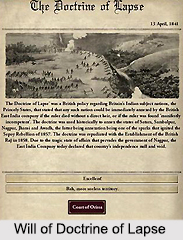 The Doctrine of Lapse was an Annexation Policy introduced by the British East India Company. Lord Dalhousie, the Governor General of India between 1848 and 1856 devised this policy and incorporated 7 states including Maratha states of Satara, Jhansi, Awadh etc. According to this doctrine, any princely state or territory under the direct rule of British East India Company, would automatically be annexed if the ruler was either "manifestly incompetent or died without a direct heir". The rule replaced the long established right of an Indian king to choose his own successor. Also the British could undertake the sovereign if they decided that the Indian ruler was not enough competent.
The Doctrine of Lapse was an Annexation Policy introduced by the British East India Company. Lord Dalhousie, the Governor General of India between 1848 and 1856 devised this policy and incorporated 7 states including Maratha states of Satara, Jhansi, Awadh etc. According to this doctrine, any princely state or territory under the direct rule of British East India Company, would automatically be annexed if the ruler was either "manifestly incompetent or died without a direct heir". The rule replaced the long established right of an Indian king to choose his own successor. Also the British could undertake the sovereign if they decided that the Indian ruler was not enough competent.
History of Doctrine of Lapse
Until the 19th century the Indian subcontinent was a patchwork of over 650 princely states. There were states from small and relatively unimportant to the large, immense powerful and colossally wealthy ruled by the Indian rulers who were called as Raja, Maharajas and other wide variety of titles.
There was an ancient Hindu custom to avoid the controversy about the succession of throne that a ruler without any male offspring of his own could adopt any male child of any age from the branch of the royal family to enthrone him as the ruler of the kingdom. In addition to this, in Rajput kingdoms there was a popular rule that a childless ruler could adopt a number of boys, called `Bhayats`, who would be brought up in the royal palace and would be groomed up as the future king. If no son of the king was born in the meantime, the would-be -king was selected from this pool of possible candidates or bhayats. Also an unsuitable or traitorous born-to-son could be excluded from the succession of the throne. In cases where ruler died before selecting a successor, any of his widows could adopt an heir, who would immediately assent the throne. The adoptee king had to cut all relationship with his birth family.
 When the British East India Company came to India in 1757, they adopted many unfair policies to grab more land as many as possible. Doctrine of Lapse was one of such policies, which contradicted directly with ancient Hindu rules and rights. Under this doctrine, the British had rights to veto the succession of an adopted heir of a princely state and they could annex the concerned territory. Although the adopted successor and his progeny were allowed to continue with their royal title and could get a substantial annual allowance. Many princely state of then India was annexed with British Emperor in this way, namely - Satara annexed in 1848. Jaitpur in 1849,Sambalpur in 1850, Baghat in 1850, Udaipur in 1852, Jhansi in 1853, Nagpur in 1854, Karauli in 1855, Awadh in 1856 etc.
When the British East India Company came to India in 1757, they adopted many unfair policies to grab more land as many as possible. Doctrine of Lapse was one of such policies, which contradicted directly with ancient Hindu rules and rights. Under this doctrine, the British had rights to veto the succession of an adopted heir of a princely state and they could annex the concerned territory. Although the adopted successor and his progeny were allowed to continue with their royal title and could get a substantial annual allowance. Many princely state of then India was annexed with British Emperor in this way, namely - Satara annexed in 1848. Jaitpur in 1849,Sambalpur in 1850, Baghat in 1850, Udaipur in 1852, Jhansi in 1853, Nagpur in 1854, Karauli in 1855, Awadh in 1856 etc.
Outcome of Doctrine of Lapse
At the time of the adoption of the Doctrine of Lapse rule, East India Company had ultimate royal administrative and jurisdiction over many regions of Indian subcontinent. This resulted in increasing discontent among the Indians, whose certain outburst was Sepoy Mutiny of 1857, in which the indigenous British army rebelled against British rulers and stood for the deposed princely states. The rebel was dominated and the Mughal Emperor was deposed in charge of supporting the rebellions.
Following this, the new British Viceroy of India called off the Doctrine of Lapse rule in the year 1858. Though the already annexed states were not restored but no new states were incorporated with the British India.



















